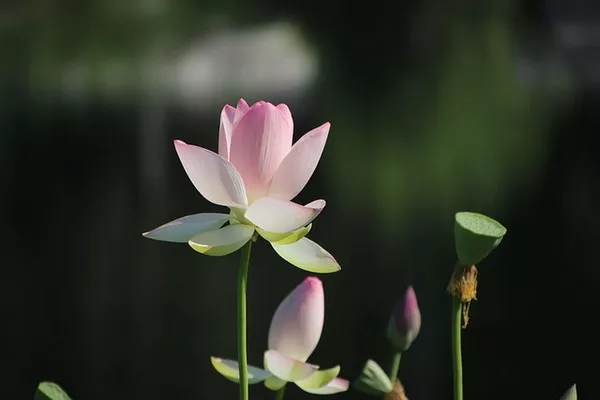Throughout history, flowers have played a significant role in human culture and symbolism. These beautiful and delicate creations of nature have been used to convey emotions, messages, and wishes. Among the vast array of flowers, one particular bloom stands out for its association with pure love and good luck: the lotus. In this article, we will explore the profound symbolism of the lotus flower and its role in representing these universal and cherished ideals.
The Lotus Flower: A Symbol of Purity
The lotus flower, scientifically known as Nelumbo nucifera, is a revered symbol in various cultures across the world. Its unique characteristics have made it a timeless emblem of purity. The lotus grows in murky, muddy waters, yet it emerges from the depths of these waters unstained and untouched by the impurities that surround it. This remarkable quality has led to the lotus being regarded as a symbol of purity and enlightenment.
In ancient Egypt, the lotus was associated with the sun god Ra and the concept of rebirth. The flower’s daily cycle of opening in the morning and closing at night was seen as a reflection of the sun’s journey through the sky and its subsequent rebirth each day. This connection between the lotus and the sun symbolized purity, enlightenment, and the eternal cycle of life.
In Hinduism and Buddhism, the lotus holds profound spiritual significance. It is often depicted as a seat for deities and spiritual figures, symbolizing divine beauty, purity, and transcendence. The lotus also represents the journey from darkness to enlightenment, as its growth from the muddy waters to the surface symbolizes the soul’s journey from ignorance to spiritual awakening.
In Chinese culture, the lotus is a symbol of purity and harmony. It is closely associated with Buddhism and Confucianism, representing enlightenment, virtue, and moral integrity. Chinese poets and artists have long used the lotus as a muse, creating beautiful works of art and literature that celebrate its grace and purity.
The Connection to Pure Love
The symbolism of the lotus as a representation of pure love can be traced back to its association with purity and enlightenment. Love, in its purest form, is often seen as a selfless and unconditional emotion, untainted by selfish desires or impurities. In this sense, the lotus flower’s ability to grow in muddy waters and remain unsullied mirrors the idea of love transcending the challenges and imperfections of life.
Moreover, the lotus flower’s gradual and exquisite unfurling of petals has been likened to the unfolding of love in one’s heart. Just as the lotus opens its petals one by one, love deepens and grows over time, revealing its beauty and purity more fully as it develops.
The Role of Color in Symbolism
The lotus flower’s color plays a crucial role in its symbolism, further enhancing its association with pure love and good luck. Different colors of lotus flowers carry distinct meanings:
White Lotus: The white lotus is the most highly regarded and is often associated with the highest levels of purity and spiritual perfection. In the context of love, the white lotus symbolizes pure and untainted love, devoid of any worldly attachments or desires.
Pink Lotus: Pink lotus flowers are commonly associated with love and compassion. They represent the budding and blossoming of love, making them a suitable symbol for romantic love that is in its early stages.
Red Lotus: Red lotus flowers are associated with passion and love that has reached its full bloom. They symbolize deep and intense love, making them ideal for expressing profound affection and romantic feelings.
Blue Lotus: Blue lotus flowers represent wisdom and the triumph of the spirit over knowledge. In the context of love, blue lotus can symbolize a love that is guided by wisdom and a deep understanding of one another.
Good Luck and Fortune
In addition to symbolizing pure love, the lotus flower is also associated with good luck and fortune. This connection can be attributed to its ability to rise above adversity and flourish in challenging conditions. In many cultures, the lotus is seen as a symbol of resilience, strength, and the promise of better times.
In Chinese culture, the lotus is often depicted alongside other symbols of good luck, such as the koi fish and the dragon, to enhance its positive associations. The lotus is believed to bring blessings of prosperity, abundance, and happiness.
In Feng Shui, the placement of lotus flowers in one’s home or garden is believed to attract positive energy and harmonize the environment. It is thought to bring about a sense of balance and well-being, contributing to a fortunate and prosperous life.
Conclusion
The lotus flower, with its rich and diverse symbolism, has earned its place as a universal emblem of pure love and good luck. Its ability to emerge untainted from the muddiest waters, its graceful unfolding of petals, and its association with purity, enlightenment, and resilience all contribute to its profound significance in cultures around the world.
Whether you seek to express a deep and untainted love or invite good luck and fortune into your life, the lotus flower serves as a timeless and meaningful symbol. Its beauty and symbolism continue to inspire art, literature, and spiritual practices, reminding us of the enduring power of love and the promise of a brighter future.


